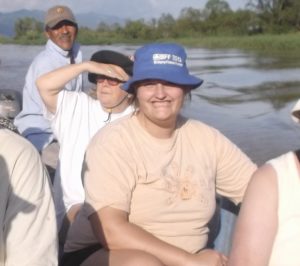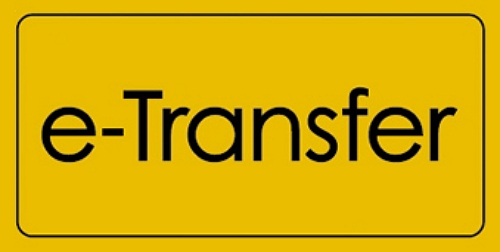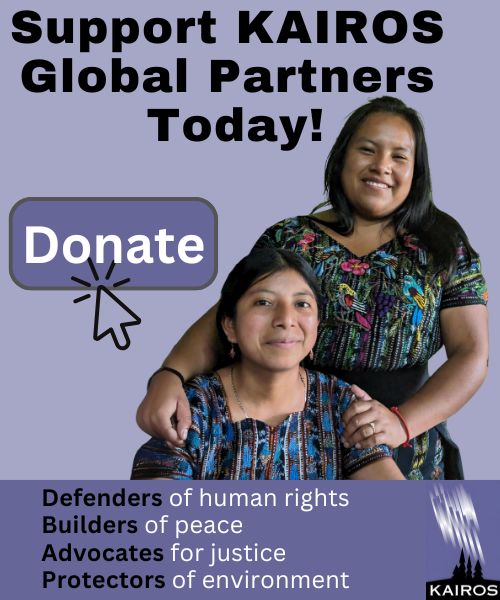Chat with Activists: Emma Seamone on activism and why she exists

Emma Seamone is an environmental activist and candidate for ministry in the United Church of Canada. She is currently taking the Atlantic School of Theology’s summer distance program, which has her leading the Bocabec, McAdam, and Upper Mills United Churches of Southwestern New Brunswick. She is a member of the Sierra Club of Canada Foundation Atlantic Canada Chapter’s Executive Committee. Originally from Wallace, Nova Scotia, Emma lives in St. Stephen, New Brunswick. She is 31 years old.
In the lead up to Streams of Justice: Atlantic Gathering, we asked Emma to share her insights as an activist living in Atlantic Canada. The following has been edited for length.
Is there a defining moment when you became an activist?
I don’t know if there was a defining moment. I grew up in a small fishing village. If the lobster stocks were down it had a direct economic impact on the place where I lived. I think I always made connections between what was happening in the environment and what was happening in communities. I also realized I am more of an academic and could understand the information that was coming from Environment Canada and explain it to people on the ground. That is the way my activism has taken form. I think it is why I chose to take environmental science in university. I saw I had that gift early on and I grew into it in high school. I decided helping communities was my calling.
When I graduated from university with an environmental science degree, I had the option to go west and work with environmental firms that were working on the tar sands but I really wanted to help communities so I stayed here and worked for the Sierra Club Canada as their volunteer coordinator for Atlantic Canada. I worked with communities all over Atlantic Canada to help them organize their activism, also making sure that they had the tools to fight back against development happening in their communities, and to envision what a new cleaner community would look like.
Who has inspired you as an activist?
Kathryn Anderson is a big continuing inspiration for me. She is currently working on the gold mining issue in Nova Scotia. We are co-chairing a committee of the United Church on issues surrounding resource extraction and climate change. She has, for a long-time, worked in solidarity in Guatemala against Canadian gold mining. A part of her work before she retired was at the Tatamagouche Centre, which is near where I grew up. When I was growing up I often heard her talk about issues associated with coffee or gold mining. She brought in speakers from Guatemala and that – as someone who grew in a tiny fishing village – made the world a lot bigger, especially to hear those issues, and how my actions in Canada affected them.
Kathryn is a long-term continuing presence in solidarity with communities and other people.
What has Kathryn taught you?
When you are leading a campaign, you can’t just go in, be with the community during the crisis, and then walk away. She originally started working in Guatemala to bring people back after the genocide, and she continued to work with the people in Guatemala when they were impacted by Canadian mining. That is a big lesson. Being in solidarity with people and making it more than any one single issue. It’s about accompanying them towards a better future.
She also taught me: just because you are told “no” doesn’t mean you should stop. Over the last several years I’ve worked with Kathryn on trying to get the United Church Pension Plan to divest from GoldCorp, one of the major companies in Guatemala. In doing so, we built awareness across the country, about the issues associated with mining and the governance of the pension plan. This has been valuable even if divestment hasn’t happened.
Any other inspirations?
Another person who inspires me is Gretchen Fitzgerald – my first boss out of university, then at the Sierra Club Canada Foundation, Atlantic Canada chapter- now the national director. She taught me to lead with a collaborative vs. hierarchal style. When I was working under her, she always allowed us to run with our own gifts. That was really helpful. Working collaboratively can be difficult because it takes a longer time, but usually the gifts you get at the end of it are better for everyone, instead of serving one person’s purpose. How to work well in a coalition, how to be humble and not expect to take all the credit, even when your efforts were key to the success – that is a key lesson I’ve learned from her. How to lead the work in a way that inspires others to do what they can, instead of getting hamstrung in by your own thoughts of how things should be done. Gretchen has inspired me towards open, collaborative leadership.
Tell me about your faith and how it connects to activism.
You might as well ask me why I exist. My morals, which I learned through church, have always been a huge part of who I am – in some ways to the detriment of my bank account. My heart is happy so that’s good. I do think part of the reason I’ve always worked in non-profits and with grassroots people is because I always had this idea that comes from scripture, that I should use my gifts to try to make the whole community better. Struggling with community, using what I can do to help other people, those are things I learned growing up in the United Church. That is a way my faith inspires me.
I also have this understanding of how helpful a church community can be in supporting you in the hardest times of your life, something a lot of people my generation don’t know because they’ve never been exposed to it. One of things I love to do is translate science for communities. I also find that I end up translating what faith or church means to people of my generation or younger, describing sometimes why I think a funeral is really important or why it is great to be part of a church community.
Also, if I am talking about climate change from the pulpit, I have to be prepared to defend what I am saying during coffee hour. That’s been a great gift to me because it’s meant that I have to constantly re-articulate what I value and why. I think some of the best work comes out of those collaborative community moments. The church has given me the place to have those discussions.
What have been the response from your peers to your message?
It depends on how open the person is. People who know me well see how confident I am, partially because I have a strong community behind me. I think that is part of it. It’s an interesting time. When I think of how many people seek out book clubs and yoga groups, and all these different things, some of what they are looking for is community. Community in church is imperfect because of politics – younger people specifically don’t want to follow a bunch of bylaws. But having a governance structure is also important. Church has things to offer but it will never be a customizable experience. You will never make everyone happy, but if you’re in it together, you can compromise. In an era of increasing polarization I feel church is a space where people of differing opinions still come together, and that’s important to me.
A lot of my peers have never been inside a church except for a funeral. Their idea of church is a place to be super sad; all of their worst memories are associated with the building. Then you contrast that with rural churches where the building is the world to them and they would never want to let it go because it represents everything their family has built or worked on for generations.
It’s hard to get people who are used to being in church to understand that sometimes it’s the physical building that is blocking people from entering.
Do you find that your peers or younger people lean towards activism?
It varies. I have friends who are super involved in a particular cause and it takes up all of their time. I have other friends who concentrate on tiny actions like stopping using plastic straws.
I think one of the struggles of my generation and those younger than us is that we are often saddled with a huge amount of student debt, which means we are working multiple jobs. I was taught that the environment is a chatter box issue for people a in secure place who have the time for those conversations. I see that in my friends. There are those preoccupied with getting their career going and trying to afford a house, and not be saddled with so much debt. We are seeing a lack of young volunteers as a result.
How do you find young people in your community dealing with the crisis of climate change?
Climate change became a big conversation when I was in high school. For my younger cousins, climate change was part of elementary school. They have been told it’s a crisis for so long but no one is doing anything about it. I think there is a lot of frustration over the lack of action.
On the other side, so many people my age have left here to go work in those very industries that we have to transition out of in order to deal with climate change. My husband and I have lots of friends who work in fracking in Alberta and they get really mad at us when we campaign against fracking. We have friends who work in the oil sands, or the Site C dam in B.C. That’s where a lot of young people in Atlantic Canada are. It makes it hard to navigate in conversations about climate change.
How are we going to have this just transition and how are we going to create an economy that allows our people to stay here? We desperately need these workers but we can’t offer the big pay cheque they can get elsewhere. During the slump in the oil sands, the welfare rate in Cape Breton skyrocketed because so many people came home. That is on the mind of a lot of people. When you hear of people supporting the Energy East pipeline, a lot of that is due to a real desire to bring some of those welders – their kids – home.
Why is Atlantic Canada such an important place for activism?
We’re the place that’s been colonized the longest. We’re the place that’s gone through boom bust economies the longest. It’s the conclusion of capitalism. New Brunswick is a great example of what a corporate monopoly looks like. Nova Scotia has had to deal with the Sydney Tar Ponds – what happens when a company goes bankrupt and you have to deal with the waste.
There’s lots of things that Atlantic Canadians can teach others because it is a part of the country that has gone through ups and downs for a long time. We have the biggest refinery and pulp and paper mills and environmental struggles. Indigenous peoples here were the first ones colonized. This is all unceded territory. We’re trying to figure out how that works in policy.
This is ground zero if you want to see what things will look like elsewhere in the country.
What would you tell young people about why they should attend Streams of Justice: Atlantic Gathering?
It’s going to be a great place to meet other people who are passionate. A wonderful place to learn what is going in Atlantic Canada, but mostly just to create community around activists. If people are looking for hope going into the climate crisis, it will be a wonderful place to find that.
Why get involved with KAIROS?
KAIROS is awesome. You have all the best staff. KAIROS is one of the few places that really make those connections between the human spirituality questions of our time and the environmental and human rights questions of our time. KAIROS is one of the few places that well articulates intersectionality, which is now becoming a buzz word. I think KAIROS has a long history of doing that well, connecting the dots.
Also from the “Chat with Activists” series: Kenn Stright on passionate activism and Hannah Gehrels on shaping change for the better
Streams of Justice: Atlantic Canada Gathering runs from May 2-5 at Mount Allison University in Sackville, NB on the ancestral and unceded territory of the Mi’kmaq. Group rates available. Register by April 15. Learn more and register: kairoscanada.org/atlanticgathering








